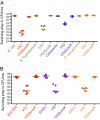The Vibrio cholerae type VI secretion system displays antimicrobial properties
- PMID: 20974937
- PMCID: PMC2984155
- DOI: 10.1073/pnas.1012931107
The Vibrio cholerae type VI secretion system displays antimicrobial properties
Abstract
The acute diarrheal disease cholera is caused by the marine bacterium Vibrio cholerae. A type VI secretion system (T6SS), which is structurally similar to the bacteriophage cell-puncturing device, has been recently identified in V. cholerae and is used by this organism to confer virulence toward phagocytic eukaryotes, such as J774 murine macrophages and Dictyostelium discoideum. We tested the interbacterial virulence of V. cholerae strain V52, an O37 serogroup with a constitutively active T6SS. V52 was found to be highly virulent toward multiple Gram-negative bacteria, including Escherichia coli and Salmonella Typhimurium, and caused up to a 100,000-fold reduction in E. coli survival. Because the T6SS-deficient mutants V52ΔvasK and V52ΔvasH showed toxicity defects that could be complemented, virulence displayed by V. cholerae depends on a functional T6SS. V. cholerae V52 and strains of the O1 serogroup were resistant to V52, suggesting that V. cholerae has acquired immunity independently of its serogroup. We hypothesize that the T6SS, in addition to targeting eukaryotic host cells, confers toxicity toward other bacteria, providing a means of interspecies competition to enhance environmental survival. Thus, the V. cholerae T6SS may enhance the survival of V. cholerae in its aquatic ecosystem during the transmission of cholera and between epidemics.
Conflict of interest statement
The authors declare no conflict of interest.
Figures







Comment in
-
Vibrio cholerae beats the competition.Nat Rev Microbiol. 2011 Jan;9(1):6. doi: 10.1038/nrmicro2493. Nat Rev Microbiol. 2011. PMID: 21204303 No abstract available.
References
-
- Bryce J, Boschi-Pinto C, Shibuya K, Black RE WHO Child Health Epidemiology Reference Group. WHO estimates of the causes of death in children. Lancet. 2005;365:1147–1152. - PubMed
Publication types
MeSH terms
Substances
Grants and funding
LinkOut - more resources
Full Text Sources
Other Literature Sources

